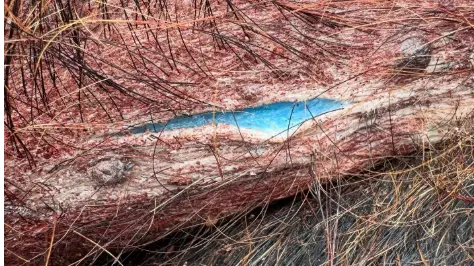Why are wild pigs turning electric blue in California? Startling colored flesh inside of animals triggers concern
-
 Wild pig intoxicated with diphacinone (Image via Facebook/@Urban Trapping Wildlife Control)
Wild pig intoxicated with diphacinone (Image via Facebook/@Urban Trapping Wildlife Control)Bizarre photos of wild pigs in Monterey County, California, with blue flesh are going viral, leaving social media users stunned. For context, when wildlife trapper Dan Burton, who owns Urban Trapping Wildlife Control, cut open a wild pig in March 2025, he was shocked to find its muscle tissue was "blueberry blue."
Upon discovery, he immediately contacted the California Department of Fish and Wildlife (CDFW), which confirmed that unusual coloration was caused by the pigs ingesting diphacinone, an anticoagulant rodenticide. According to CDFW, the hogs either ate the rodenticide bait or ate other animals that had ingested rodenticides.
In a statement, the CDWF stated:
"Wild pigs in the Monterey County area were exposed to pesticide bait containing the anticoagulant rodenticide diphacinone, according to findings by the California Department of Fish and Wildlife’s (CDFW), Wildlife Health Lab (WHL) and the California Animal Health and Food Safety Laboratory in Davis."
The authorities also warned that the blue coloring from the toxin may not always be present in animals that have ingested it. Although diphacinone isn't banned in the United States, it is a restricted chemical in California, per National Geographic.
According to a-z-animals, the odorless anticoagulant rodenticide comes in a crystalline form, which is then crushed into powder and used to eliminate target species.
Meanwhile, on July 7, Burton's firm also took to Facebook to warn individuals, especially those near the Salinas River, about the findings.
"The pig in this post tested positive for diphacinone, an ingredient commonly found in rodenticides used to control rodent populations. While the Urban Trapping team was removing feral pigs from South Monterey County, we noticed something out of the ordinary: all the pigs' fatty tissue was stained blue."
Consuming contaminated meat causes severe health complications
Colorado Rabbits with Tentacles and now this
— SynCronus (@syncronus) August 18, 2025
Wild pigs with blue meat found in California, officials sound alarmhttps://t.co/OrbVy7skpL pic.twitter.com/2iDkAJlPyHInvented in 1962, diphacinone, an anticoagulant used to control populations of squirrels, rats, and mice, is dyed blue to help humans easily identify it. If ingested, it could cause serious health issues, including nosebleeds, gum bleeding, blood in urine, bloody stools, low blood pressure, abdominal pain, and other serious complications, per the outlet.
Diphacinone also causes severe bleeding in humans and other mammals, eventually causing death, as per National Geographic
Hunters also issued a warning from authorities for possible contamination, as cooking the meat does not neutralize the poison. CDFW Pesticide Investigations Coordinator Dr Ryan Bourbour, in a statement, explained:
"Hunters should be aware that the meat of game animals, such as wild pig, deer, bear and geese, might be contaminated if that game animal has been exposed to rodenticides. Rodenticide exposure can be a concern for non-target wildlife in areas where applications occur in close proximity to wildlife habitat."
CDFW also urged hunters to report any unusual findings, such as blue coloration in the tissue of animals, and warned against consuming any part of animals that show blue fat, muscles, and other abnormalities. Additionally, pesticide applicators were advised to take measures to ensure that rodenticides are applied in a way that does not expose non-target species.
The officials also emphasized the importance of checking whether wildlife is present in the area before applying the anticoagulant and recommended using proper bait stations and application methods to prevent access to non-target species.
"Using an integrated pest management approach for rodent control may help reduce the opportunities for rodenticide exposure for non-target wildlife," they added.
Meanwhile, studies have also detected anticoagulant rodenticides in black bears, mountain lions, California condors, bobcats, San Joaquin kit foxes, red-tailed hawks, and northern spotted owls.
TOPICS: Wild Pigs, Diphacinone, Anticoagulant rodenticide